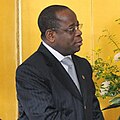Top Qs
Timeline
Chat
Perspective
President of the Council of Ministers of Togo
Head of government of Togo From Wikipedia, the free encyclopedia
Remove ads
The president of the Council of Ministers of the Togolese Republic (French: Président du Conseil des Ministres de la République togolaise), commonly referred to as prime minister of Togo (French: Premier ministre du Togo) which was also its former official name, is the head of government of the Togolese Republic. Most of the governing authority and executive powers lie in the president of the Council of Ministers, while the president of the Republic is a largely ceremonial role.
The prime minister is appointed by the president and can serve indefinite terms for up to six years; however, the prime minister has to enjoy the confidence of the majority of National Assembly members, who are directly elected every six years. A total of fourteen people have served as president of the Council of Ministers – thirteen men and one woman. Among them, one person, Edem Kodjo, has served on two non-consecutive occasions. The incumbent prime minister, Faure Gnassingbé, has served since 3 May 2025.
Remove ads
History of the office
Summarize
Perspective
1991 conflict with the presidency
In the months following the appointment of Joseph Kokou Koffigoh as prime minister by the National Conference on 27 August 1991,[1] the soldiers of the Togolese Armed Forces (FAT) loyal to President Gnassingbé Eyadéma repeatedly tried to oust Koffigoh:
- On 1 October 1991, the soldiers seized the national radio and television station and demanded that Koffigoh resign[1][2] before leaving the station; Koffigoh said afterwards on the radio that order was restored.[2]
- On 8 October 1991, the soldiers unsuccessfully tried to kidnap Koffigoh, and four people were reported killed in protests and violence that followed.[3]
- In late November 1991, the soldiers began a siege of Koffigoh's official residence in Lomé after Eyadéma's party, the Rally of the Togolese People (RPT), was banned by the transitional High Council of the Republic (HCR).[4] They demanded that Koffigoh's government be replaced and threatening to "reduce the city to ashes";[5] they also demanded that the RPT be legalized again and that the HCR be dissolved.[6] Koffigoh called for French military aid. Eyadéma publicly called on the soldiers to return to their barracks and expressed continued trust in Koffigoh, but also invited him to begin consultations on the formation of a new national unity government.[5] After two days of talks, the soldiers lifted their siege;[6] however, they promptly resumed it.[7] Koffigoh then offered to include supporters of Eyadéma in the government, but he refused to dissolve his government altogether, and he again called for French aid.[8] On 3 December 1991, the soldiers succeeded in capturing Koffigoh in a heavy assault on his official residence, involving tanks and machine guns. Many people were killed in this violence:[9][10] at least 17,[9] and possibly more than 200.[10] The soldiers then took Koffigoh to meet with Eyadéma,[9] who was widely believed to have been behind the soldiers' actions, although he did not take responsibility for them. Later on the same day, Eyadéma released a statement saying that he and Koffigoh would form a new transitional government. Although Koffigoh remained in office, his power was considered curtailed.[10] On 31 December, a new government headed by Koffigoh was announced, including three members of the RPT; most members of the previous government remained in their posts.[4]
2024 constitutional reform
In March 2024, President Faure Gnassingbé has announced a new constitution. The proposed new constitution turns Togo from a presidential system to a federal parliamentary one, weakening the powers of the president, strengthening the powers of the prime minister and renaming the office the President of the Council of Ministers, and as well as giving the new role a maximum term of six years. The new constitution was adopted in April 2024 after a vote in parliament and officially came into force the following month, thus creating the Fifth Republic.[11]
The changes officially came into force on 3 May 2025, nearly one year after the new constitution came into force. Gnassingbé became the president of the Council of Ministers and thus, retaining most of the powers in the country and becoming Togo's leader for life.[12][13] The president, now officially a ceremornial role, was handed over to Jean-Lucien Savi de Tové, a former opposition leader during the presidency of Gnassingbé's father. Savi de Tové was unanimously elected by the National Assembly and immediately sworn in president, became the oldest person to hold the office, aged nearly 86.[14][15]
Remove ads
Duties and competences
Summarize
Perspective
The president of the Republic appoints the prime minister. He terminates his functions.[16]
The prime minister is the head of the Government. He directs the action of the Government and coordinates the functions of the other members. He presides over the Committees of Defense. He substitutes for, the case arising, the president of the Republic in the presidency of the Councils provided for in Articles 66 and 72 of this Constitution. He assures the interim of the head of the State in case of incapacity for cause of illness or of absence from the national territory.[17]
Before his entry into office, the prime minister presents before the National Assembly the program of action of his Government.[17]
The National Assembly accords its confidence to him by a vote with the absolute majority of its members.[17]
The prime minister assures the execution of the laws.[18]
He may delegate certain of his powers to the ministers.[18]
The acts of the president of the Republic other than those provided for in Articles 4, 66, 68, 73, 74, 98, 100, 104 and 109 of this Constitution, are countersigned by the Prime Minister or, the case arising, by the Ministers given the charge of their execution.[19]
Remove ads
List of officeholders
- Political parties
- Other factions
Remove ads
Timeline

See also
References
External links
Wikiwand - on
Seamless Wikipedia browsing. On steroids.
Remove ads















